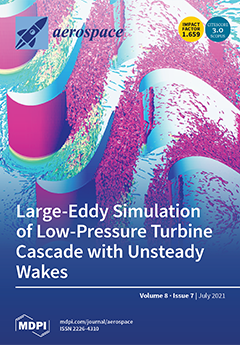Wake vortex encounters (WVE) can pose significant hazard for en-route aircraft. We studied the sensitivity of wake vortex (WV) circulation and decay to aircraft mass, altitude, velocity, density, time of catastrophic wake demise event, eddy dissipation rate, wing span, span-wise load factor, and
[...] Read more.
Wake vortex encounters (WVE) can pose significant hazard for en-route aircraft. We studied the sensitivity of wake vortex (WV) circulation and decay to aircraft mass, altitude, velocity, density, time of catastrophic wake demise event, eddy dissipation rate, wing span, span-wise load factor, and WV core radius. Then, a tool was developed to compute circulations of WV generated/encountered by aircraft en-route, while disregarding unrealistic operational conditions. A comprehensive study is presented for most aircraft in the Base of Aircraft Data version 4.1 for different masses, altitudes, speeds, and separation values between generator and follower aircraft. The maximum WV circulation corresponds to A380-861 as generator: 864 and 840 m
2/s at horizontal separation of 3 and 5 NM, respectively. In cruise environment, these WV may descend 1000 ft in 2.6 min and 2000 ft in 6.2 min, while retaining 74% and 49% of their initial strength, respectively. The maximum circulation of WV encountered by aircraft at horizontal separation of 3 NM from an A380-861 is 593, 726, and 745 m
2/s, at FL200, FL300, and FL395, respectively. At 5 NM, the circulations decrease down to 578, 708, and 726 m
2/s. Our results allow reducing WVE simulations only to critical scenarios, and thus perform more efficient test programs for computing aircraft upsets en-route.
Full article


